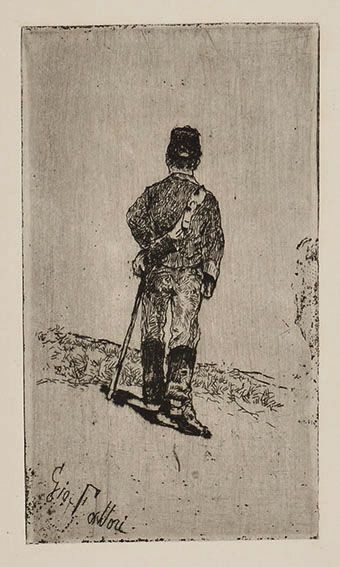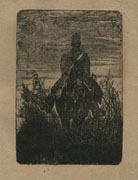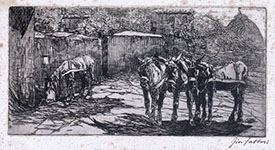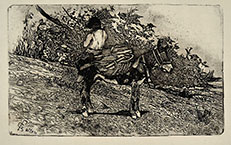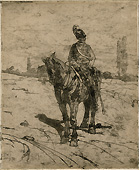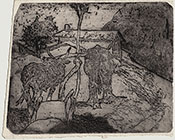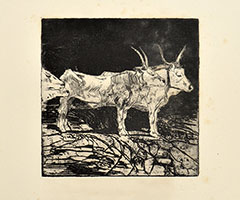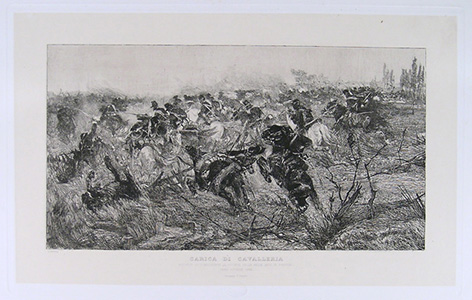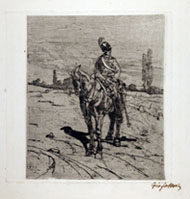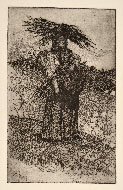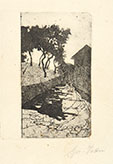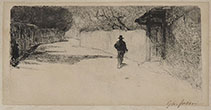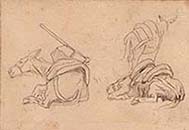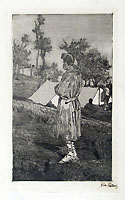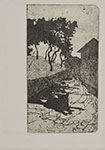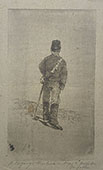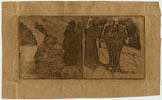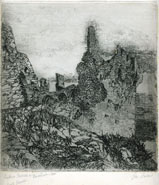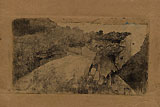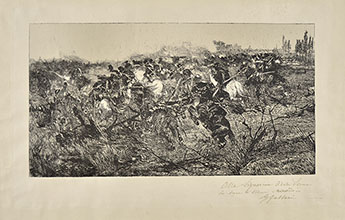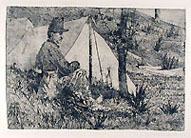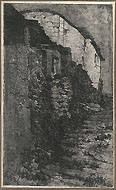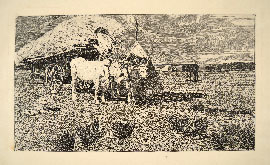(Livorno 1825 - Florence 1908)
UN SOLDATO (A soldier)
Etching on zinc, Baboni-Malesci XVIII. Signed in the plate Gio Fattori.
A fine impression in black ink. I compared this impression with the one at the GDS Uffizi (inv. n. 21465). Both specimens are pulled on the same type of ivory wove paper, and the inking too is very similar, with a rich tone left on the plate. Our example shows, however, a greater intensity of the inking, particularly in areas where the hatching is thicker, like on the hat, on the boots and on the shadow projected by the soldier.
To the platemark 168 x 93 mm; the full sheet measuring 372 x 274 mm.
At the GDSU I wanted to check also the impression of Un Soldato coming from the Rosselli collection (inv. GAM 219). The selection of Fattori's etchings assembled by Emanuele Rosselli in Viareggio, then presented to the Florentine Galleria d'Arte Moderna, is a really fine group of impressions, including many artist's proofs. Looking carefully at the Rosselli specimen I noticed that it is a working proof before the signature and other etched work on the plate, mainly on the left side. In fact the signature has been written in pen and brown ink, and the sheet has been touched in pen to draw the leaves of grass on the left of the soldier.
Then Fattori traced with a stylus the signature and part of the drawn leaves to transfer those passages on the plate. The tracing is visible on the print as thin white lines, which correspond to the new etched areas of the final state.
The Rosselli specimen was published for the first time by Cristina Bonagura in 1976. See the catalogue of the exhibition, le Acqueforti di Fattori della collezione Rosselli: Firenze, La Meridiana di Palazzo Pitti, June-December 1976, no. 23. The scholar noticed the touches in pen but did not realize that the impression was an artist proof, then used to complete the etched work of the plate.
In 1998 Andrea Baboni exhibited again the Rosselli specimen in Verona and Livorno, see A. Baboni – G. Cortenova, Giovanni Fattori, exhibition catalogue Verona Galleria d’Arte Moderna e Contemporanea Palazzo Forti – Livorno, Museo Civico Giovanni Fattori, Milan 1998. The scholar just described the impression as printed by Fattori himself at the end of 19th century, with defective inking on the left.
Giovanni Fattori, possibly the most important painter of the nineteenth century in Italy, received his first instruction in drawing from a lesser painter of his native town. In 1846 Fattori moved to Florence to attend the Academy. During the 1850s Fattori joined the innovative artists, called Macchiaioli, who met at the Caffè Michelangelo in Florence and were champions of a new technique and style to contrast the conventional academic language. During those years, he still produced works that could be attributed to the historical-romantic school but his interest in studying from life also extended to landscape painting and the military life of the day became the subject of his first experiments in painting using the macchia technique. In 1867, after the death of his first wife, Fattori frequently stayed in the Maremma region which became the ideal backdrop for his works. Fattori began etching in the early 1880s, when he was nearly sixty; quite soon he was able to appreciate the difference of expression he could achieve using this new medium. A real peintre-graveur, he continued with etching his artistic research on light and essential shapes in reality.
